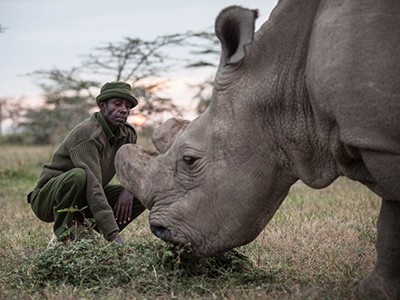
A baby green sea turtle in Madagascar, one of the regions where the probability of widespread biodiversity loss is greatest.Credit: Alexis Rosenfeld/Getty
For more than 30 years, the international community has tried and failed to find a path to slow down — and eventually reverse — worldwide declines in the richness of plant and animal species. Next year, it will have another chance. The 15th Conference of the Parties (COP 15) to the United Nations Convention on Biological Diversity, recently delayed for the third time, is now slated to take place in person in Kunming, China, in April and May 2022.
Biodiversity is fundamental to Earth’s life-support systems, and humans depend on the services that nature provides. In 2010, countries committed to slowing the overall rate of biodiversity loss by 2020. But just 6 out of the 20 targets that were agreed on that occasion — at COP 10 in Aichi, Japan — have been even partially met, notable among them a commitment to conserve 17% of the world’s land and inland waters.
Ahead of the Kunming meeting, policymakers and scientists are discussing a new action plan, called the Global Biodiversity Framework, which they hope to agree next year. The latest draft (published in July; see go.nature.com/3kbvspd) includes a promise to conserve 30% of the world’s land and sea areas by 2030 and reiterates the need to meet earlier targets, including the provision of greater financial support to low-income countries to help them to protect their biodiversity.
Missing link
Researchers around the world are advising on the plan, through the UN’s institutions and through universities and various scientific networks. But one piece of the puzzle is missing. In 2012, a host of governments established the Intergovernmental Science-Policy Platform on Biodiversity and Ecosystem Services (IPBES). It periodically reviews the literature and provides summaries of the latest knowledge. However, the countries organizing the COP are not involving IPBES in the action plan in the way that the UN Intergovernmental Panel on Climate Change has been consulted for advice ahead of climate COPs. It is important that IPBES be asked, because policymakers are being presented with a range of ideas that would benefit from the systematic evaluation that a global scientific advisory body would bring.
The world’s species are playing musical chairs: how will it end?
For example, biodiversity terminology is often unfamiliar, and therefore challenging, for most policymakers. The word itself — defined by the biodiversity convention as the variety and variability of life on Earth, at the level of genes, species and ecosystems — is not commonly used, nor well understood beyond the scientific community. The magnitude of biodiversity’s value to the planet and to people, as well as the risks of losing it, are also not widely appreciated.
Over the years, various teams of scientists have researched and offered ideas on how to communicate the state of biodiversity both accurately and in a way that is accessible and engages the wider public. Some are advocating a biodiversity equivalent of the 1.5 °C warming target, or of net-zero emissions. One suggestion, published last year, is for the international community to adopt a target for limiting species extinctions. The goal would be to keep extinctions of known species to below 20 per year globally for the next 100 years — a single headline number to represent biodiversity (M. D. A. Rounsevell et al. Science 368, 1193–1195; 2020).
A focus on species extinctions as a proxy for biodiversity is not a new idea, and is controversial. However, the authors say that their intention is not to replace biodiversity’s many facets with only one number, but to communicate biodiversity in a way that would resonate with more people.
Another group is proposing a composite index — a single score made up of measures of some of biodiversity’s main components, including the health of species and ecosystems, as well as the services that biodiversity provides to people, such as pollination and clean water (C. A. Soto-Navarro et al. Nature Sustain. https://doi.org/gmjs2f; 2021). This would be biodiversity’s equivalent of the UN Human Development Index — first published in 1990 — which amalgamates information on health, education and income into a single number and has been adopted worldwide as a measure of prosperity and well-being.
Fewer than 20 extinctions a year: does the world need a single target for biodiversity?
A third idea, published by the leaders of some of the world’s most influential conservation and environmental science organizations, is called Nature Positive (see go.nature.com/2ydk89n). Its authors are proposing that the UN’s many global environmental agreements should include three common targets: no net loss of nature from 2020 (meaning that although nature might continue to be degraded in some areas, this would be offset by conservation gains elsewhere); some recovery by 2030; and full recovery by 2050. At present, the UN agreements on biodiversity, stopping climate change and combating desertification all have their own processes, occasionally acting together, but more often operating independently. The goal is to get them to sign up to one set of principles.
All of these ideas have advantages and risks, which is why they need to be systematically evaluated by researchers. That’s where IPBES’s role is crucial. IPBES comprises a broad community of researchers, and, importantly, it represents voices from under-represented low- and middle-income countries, as well as the world’s Indigenous peoples. The governments involved in organizing the Kunming COP should ask IPBES to evaluate the ideas being put forward for the next biodiversity action plan, so they can be confident that what they decide has the support of a consensus of researchers, particularly in more-biodiverse regions of the world. Although preparations for the Kunming COP are well under way, this could also happen after the COP.
Biodiversity loss could be as serious for the planet — and for humanity — as climate change. World leaders have become skilled at organizing complex international meetings and making promises that they then fail to keep. The upcoming biodiversity COP risks being one more such event, which is why researchers offering solutions are right to feel frustrated. They should work with IPBES to review their ideas. A unified voice is powerful, and if scientists can present a united front, policymakers will have fewer excuses to continue with business as usual.

 The world’s species are playing musical chairs: how will it end?
The world’s species are playing musical chairs: how will it end?
 Fewer than 20 extinctions a year: does the world need a single target for biodiversity?
Fewer than 20 extinctions a year: does the world need a single target for biodiversity?
 The biodiversity leader who is fighting for nature amid a pandemic
The biodiversity leader who is fighting for nature amid a pandemic
 The United Nations must get its new biodiversity targets right
The United Nations must get its new biodiversity targets right






